

Grafted into the family
by Mike Oettle
ADOPTION has proved to be a less interesting topic for writers on heraldry than bastardy. There would seem to be two reasons for this:
Firstly, the act of adoption – legally making a child one’s own, regardless of his or her origins – is often accompanied by an expungement of the child’s past, either legally or in what the child is told of his or her parentage, leaving a blank slate.
Of course, many adopted children have been born to parents regularly married. But equally, adoption is often a means of eliminating the (sometimes embarrassing) consequences of bastardy.
Secondly, an adopted child has a choice between bearing the arms of his (her) adoptive father, or reverting to the arms of the natural father (in whatever way this is possible).
This means that many adopted sons have borne the arms of the family they were born into, and the adoptive family’s arms remain unaffected.
But whatever the reasons, the standard works on heraldry have few examples of arms of adoption, and most give no actual instances.
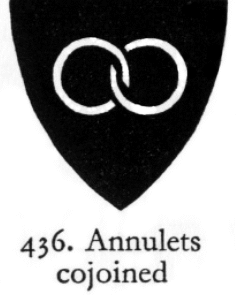
Boutell[1] does not even mention England specifically, but refers to a Royal Licence (required in England, and only there, for permission to adopt a name and the arms belonging to it) and says: “When such a licence is granted, and it normally is, the arms are exemplified with two interlaced annulets as a mark of distinction.”
The book’s glossary and index includes a sketch of a shield charged with interlaced annulets alone (a mere example of the charge, not a coat of arms at all) and leaves it at that.
Franklyn and Tanner’s[2] entry for adoption merely cross-refers to “bastardy, indication of:”, at which entry the second-last paragraph reads:
“An adopted child is in precisely the same position armorially as an illegitimate. If he is to perpetuate his foster father’s arms he must receive a grant of the pronominal quarter ‘suitably differenced’. The prevailing mark is a plain canton on the shield, and on the crest a cross-crosslet.”
Brooke-Little, in a footnote to Fox-Davies,[3] remarks:
“It is now quite usual for an adopted child to be granted a Royal Licence to bear the arms of its adoptive father differenced by two links of a chain. In Scotland a voided canton on the arms of the adopted father is used.”

Adoption is not even mentioned by name in Moncreiffe and Pottinger’s Simple Heraldry,[4] but a single example is illustrated in the arms of Robert Nevill, Bishop of Durham, who bore conjoined annulets at the centre of the Nevill saltire. (For more about these arms, see here.)
In total, then, you have four different marks: conjoined annulets (ring-shaped), two links of chain (distinguished from annulets by being rectangular with rounded corners), a plain canton (one with colour but no charge), and a voided canton (one with a coloured outline but no content, even its own colour, but revealing the shield behind) – yet not a single example specifically mentioned in text, and only one illustrated.
The links of chain are a curious symbol, not because of their inappropriateness – conjoined annulets and chain links are both sound symbols of the joining of families – but because they are in conflict with the cadency marks noted in a College of Arms document for a 10th, 11th and a 12th sons in a family.
Of the sources I have consulted, only Brooke-Little mentions it (in a footnote to Fox-Davies, so Richmond Herald is almost contradicting himself). He remarks that “a book of Lincolnshire church notes” at the College lists these brisures for the family of Tournay:
A buckle for the 10th, an escallop for the 11th and links of chain for the 12th.
I have found no other brisures listed anywhere for sons of this order, but this could be that they are infrequently encountered as armigers.
All the same it is interesting that the most commonly seen arms of adoption are not even mentioned by any of these authorities.
I refer to the arms borne by the House of Bernadotte, kings of Sweden since 1818.


King Carl XIII of the House of Holstein-Gottorp succeeded to the Swedish throne in 1809 after the failure of the male line of descent from his brother Gustav III. Carl’s own marriage was childless.
He firstly adopted Denmark’s Prince Christian (a distant relative) as his heir, but Christian died in 1810.
Carl then chose to adopt a Gascon soldier, Jean-Baptiste[5] Bernadotte, one of Napoleon I’s marshals and created Prince of Ponte Corvo by Napoleon. Jean-Baptiste then adopted the name of his adoptive father Carl.
Now called Carl Bernadotte, he sidestepped the Battle of Waterloo in 1814 and instead marched on Copenhagen, forcing the Danish King to cede Norway to Sweden.


Since 1448 the Kings of Sweden have borne the three gold crowns on blue of the Union of Kalmar[6] quartering the arms of the House of Folkunga (azure, three bendlets sinister argent, a lion rampant crowned or), kings of Sweden from 1275 to 1359, separated by the arms of a gold cross. In addition to these quarterings, the Swedish kings have also since that time borne an inescutcheon indicating their dynastic origins.
The Holstein-Gottorps, kings from 1751, bore the quarterings of the Dukes of Oldenburg (including a Herzschild of Oldenburg and Delmenhorst) in this position. Interestingly, the first quarter of the outer escutcheon in this combination displayed the axe-wielding crowned lion of Norway (in gold on red).

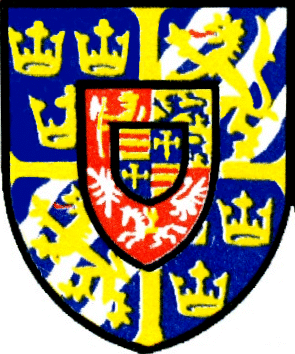
In 1814, Carl XIII marked the acquisition of Norway by removing the quarterings of Kalmar and Folkunga from the sinister half of the shield and replacing them with the Norwegian lion. (The Norwegian lion then appeared twice in this achievement.)
On becoming king as Carl XIV in 1818, Bernadotte rearranged these arms. Replacing the cross with a pall, he placed the three crowns of Kalmar in chief, with the lion of Norway in the dexter third and the lion of Folkunga in the sinister.
The significant change, however, was not so much in the rearrangement of the territorial arms, but in the inescutcheon: he reverted to the arms of House of Vasa (kings from 1523 to 1599) and impaled them with his own Bernadotte arms.
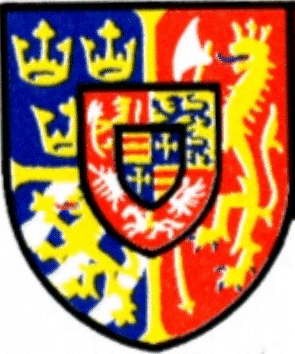
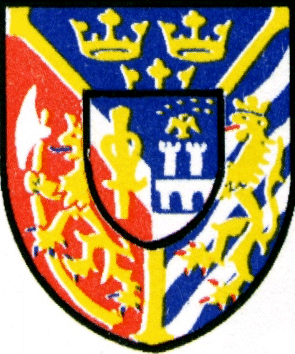
Carl XIV’s grandson Carl XV, on becoming king in 1859, returned to the pattern of Norway in the sinister and the two Swedish quarterings in the dexter half of the shield, but retained the inescutchon of Vasa impaling Bernadotte.
In 1905, to avert a war, Norway was permitted to become a kingdom in its own right. Prince Carl of Denmark then became King Haakon VII of Norway, and King Oscar II of Sweden (brother of Carl XV) reverted to the earlier arms of Kalmar quartering Folkunga – yet retaining the inescutcheon of Vasa impaling Bernadotte.

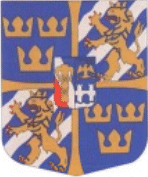
Interestingly, Oscar II’s son, King Gustav V, married a descendant of Gustav III.
The present King of Sweden, Carl XVI Gustav (great-grandson of Gustav V), still retains the inescutchon of Vasa impaling Bernadotte.
